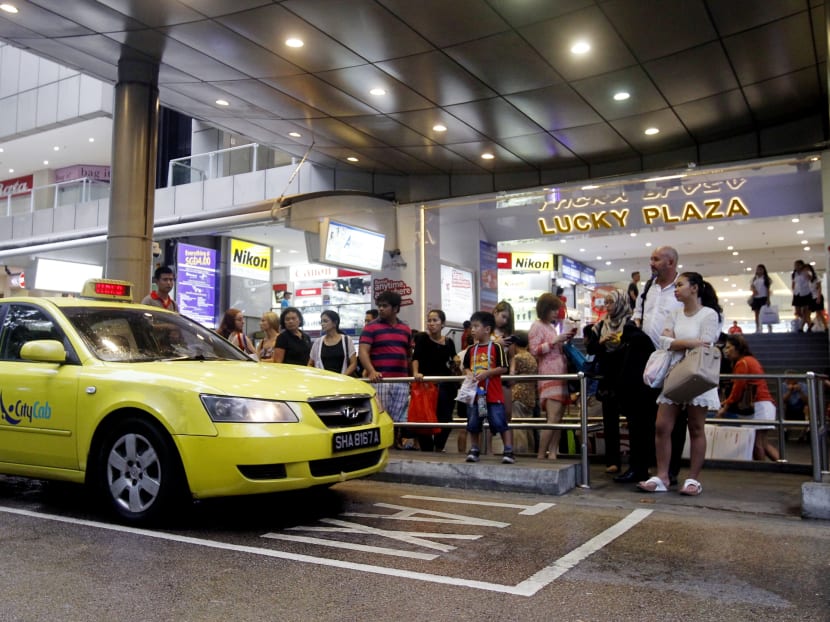Taxi companies hit roadblock in meeting availability standards
SINGAPORE — Despite tweaks to the taxi availability standards and their computation, some taxi companies continue to have problems meeting the standards set by the Land Transport Authority (LTA).
SINGAPORE — Despite tweaks to the taxi availability standards and their computation, some taxi companies continue to have problems meeting the standards set by the Land Transport Authority (LTA).
In the latest adjustment, the authority will compute these standards based on taxi companies’ hired-out fleet instead of the total registered fleet, which will be applied retrospectively from Jan 1 this year, the LTA said today (June 30).
This is the latest in a series of tweaks the authority has made to the availability standards since they were introduced in 2013.
In November, it lowered the required percentage of taxis clocking the minimum daily mileage for weekends and public holidays.
The LTA said the new adjustment took into account feedback from the National Taxi Association (NTA) and taxi companies.
Using only the hired-out fleet to compute availability standards “removes the variation” from unhired taxi fleet, and measures the efficiency of hired taxis more accurately.
“Importantly, taxi drivers would not have to increase their mileage to make up for the non-performance of the unhired taxis,” the LTA said.
A small percentage of the taxi company’s fleet may be unhired at any one time, noted the LTA.
In April, for example, 3.9 per cent of taxis across the industry were unhired. Some of these taxis are being maintained, used as spares or are waiting to be rented to drivers.
Currently, the LTA computes standards based on the registered fleet as it wants companies to deploy as many taxis that have been registered and allocated special Certificate of Entitlements (COEs) as possible.
Based on the hired-out fleet, only two companies were penalised for not meeting the second-year availability standards used for determining financial penalties.
SMRT was penalised a total of S$44,990 in January and February, while Prime was penalised about S$43,800 for the January to March period.
If their performance was computed based on the registered fleet, another two companies, Trans-Cab and Premier, would also have failed to meet standards, said the LTA in response to queries.
It added that the availability standards remain unchanged.
Taxi companies need to have at least 60 per cent of their hired-out fleet plying the roads during the peak periods of 6am to 7am and 11pm to midnight; and 85 per cent of the fleet on the roads from 7am to 11am and 5pm to 11pm.
Likewise, 85 per cent and 75 per cent of the fleet need to achieve the minimum daily mileage of 250km on weekdays and weekends and public holidays respectively.
Taxi companies are required to pass standards for both indicators in at least four months out of every six-month period in order to be allowed to grow their fleet — capped at 2 per cent per annum.
Based on the hired-out fleet, the percentage of taxis on the road during peak periods has increased from 82.4 per cent in 2012 to 90 per cent in the first four months of the year. This meant that over 2,000 more taxis were available to commuters during these hours, the LTA said.
NTA executive adviser Ang Hin Kee welcomed the adjustment, noting that as every active taxi driver had to take on the responsibility of having taxi operators’ entire fleet size meet the standards, the adjustment makes “practical sense”.
But with more efforts to hire empty taxis which in turn, lead to fewer relief drivers, he added that more concerted efforts are needed to increase the number and share of relief drivers to “meet customers’ demand for taxis, and make public transport a more attractive point-to-point option”.
Mr Ang added that meeting the daily 250km standard now becomes “less of a useful proxy to meet demands”, where the use of apps has helped better match passengers to taxis and improving the availability of taxis.
Mr Patrick Nathan, vice-president of SMRT corporate information and communications, noted that there is still room for improvement for the minimum daily mileage standard and the operator is stepping up efforts to help its drivers achieve it.
For instance, SMRT introduced the Taxi Availability Mileage Counter on its taxis’ Mobile Data Terminal to help drivers monitor their travelled mileage after every metred trip, he added.
Group corporate communications officer with ComfortDelgro Tammy Tan said the company will continue to work with its drivers to meet the taxi availability standards.
ADDITIONAL REPORTING BY JORDON SIMPSON







